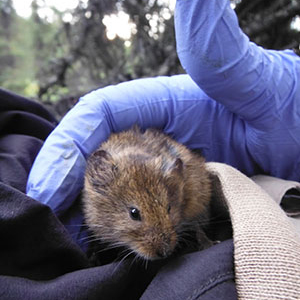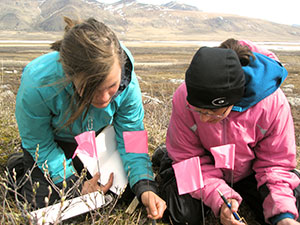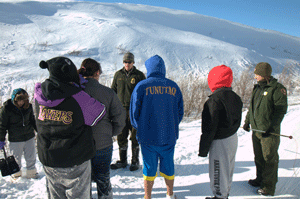The Murie Science and Learning Center (MSLC) funds numerous outreach projects through the Science Education Microgrant program. The microgrants help MSLC partner parks pay for science education outreach projects. Funding for the microgrants is provided by Alaska Geographic.
From the Field to the Laboratory: Engaging Youth in Field Studies and Museum Curation

NPS Photo / Sarah Swanson
Project Coordinator: Melanie Flamme (NPS, Yukon-Charley Rivers National Preserve and Gates of the Arctic National Park and Preserve)
From trapping voles in the field to curating them in the laboratory, a team of Fairbanks high-school students and Student Conservation Association (SCA) interns received holistic training in museum studies and field research this summer. The team prepared over 500 museum-quality vole and shrew specimens from Denali National Park and Preserve, which will be housed in the University of Alaska Museum collection.This represents the largest series of its kind from Alaska, and perhaps from any National Park in the country. The students also gained valuable field experience by helping researchers survey and live-trap small mammals in Fairbanks and Denali. Through these experiences, the students learned about museum science and curation, zoological collections, and small-mammal field techniques while developing professional contacts and marketable job skills in wildlife biology. Funding from the Murie Science and Learning Center, SCA and University of Alaska Fairbanks enabled this highly successful project.
North for Science!

NPS Photo
Project coordinators: Carol Scott, Fairbanks Science Educator, Maria Berger, Gates of the Arctic National Park Education Specialist, Karen Deatherage, BLM Representative
This summer, a group of eight middle school students traveled up the Dalton Highway to aid in ongoing research projects as part of the North for Science expedition. The purpose of the expedition was to immerse young teens in field science experiences using Alaska's public lands as living laboratories. The students camped during their week-long journey, starting in Coldfoot and then driving north to Galbraith Lake. While in the field, they installed nest boxes, recorded data for an ongoing snowshoe hare project, compared transect data from boreal forest and tundra locations, and investigated research projects at the Toolik Field Station. All team members enjoyed the outdoor experience while learning and being inspired by the science professionals they met and the land they traveled through.
Where are the wood frogs?: Looking to citizen science to aid monitoring efforts.

NPS Photo
Project coordinator: Stacia Backensto
Amphibians are declining worldwide, including in national parks. To help understand and combat this trend, National Park Service scientists from the Central Alaska Networkteamed up with the Alaska Herpetological Society this summer to teach local communities how to monitor wood frogs in their own backyards. These initial community efforts herald the beginning of a long-term program to increase public awareness about wood frogs and engage citizens in monitoring wood frogs in their local wetlands. Frog monitoring kits are available for loan to educators and citizens in Fairbanks, McCarthy, and Copper Center. Contact Amy Larsen for more information. This project was supported in part by the Murie Science and Learning Center.
Engaging Kotzebue kids in citizen science via voles

NPS Photo
Program Coordinators: Linda Jeschke and Gina Hernandez (NPS, Western Arctic National Parklands)
This August, students from the Kotzebue community participated in a two-day camp designed to establish understanding of the work of NPS park rangers. During the camp, students participated in a small mammal population study that included the catch and release of red-backed voles. The ultimate goal of the camp is to encourage students to develop their own interest in science, and maybe even spark their interest in pursuing a land management career!
Bringing back the Trash-to-Art Programs in Fairbanks Schools

NPS Photo / Melanie Flamme
Project Coordinator: Melanie Flamme (NPS, Yukon-Charley Rivers National Preserve and Gates of the Arctic National Park and Preserve)
This spring, the city of Fairbanks greeted the return of the Center for Alaskan Coastal Studies (CACS) for the public unveiling of a student-created trash sculpture: a life-sized black bear made out of aluminum cans. The sculpture was created as part of the 2013 Trash-to-Art project funded by Murie Science and Learning Center (MSLC). In 2014, the sculpture was used as a prop by a team of educators, artists and biologists to help illustrate the "Story of Stuff" to over 400 Fairbanks students. The recycled sculpture illuminates the lifecycle of trash in the environment and how to repurpose trash invaluable and symbolic ways. The bear sculpture will be installed in Fairbanks' Peirce Park where it will serve as a symbol of environmental awareness for the community to enjoy. The project was supported and facilitated by the MSLC, the Center for Alaskan Coastal Studies, the National Park Service and Effie Kokrine School.
Alaska Adventure Ranger Program brings kids to public lands

NPS Photo
Project Coordinator: Amanda McCutcheon and Rachel Jencks, NPS Education Specialists
The Alaska Adventure Ranger Program promotes Junior Ranger programs across Alaska. The program includes 13 public land sites from all corners of Alaska. Program participants who complete Junior Ranger programs at any three of the public land sites receive an additional special patch. During the 2014 summer season, the program’s sixth year, 700 participants completed the Alaska Adventure Ranger program. Additionally, it was noted that sites across Alaska showed increased participation and therefore there was an increased demand for supplies, such as patches, worksheets, and decals. This MSLC Microgrant ensures that this program will continue its growth in 2015 through the purchase and distribution of patches and booklets for all participating public lands.
Sheep Skeleton Project: Connecting youth with sheep biology and archaeology

NPS Photo
Project Coordinator: Joe Keeney, Marcy Okada and Kumi Rattenbury (NPS, Gates of the Arctic National Park and Preserve
Scientists and subsistence/outreach coordinators with Gates of the Arctic National Park and Preserve will partner with teachers and students at the Nunamiut School and hunters in Anaktuvuk Pass to prepare a Dall's sheep skeleton from head to tail. This project is part of a cooperative educational program that will teach students sheep biology, wildlife conservation and archaeological methods. Modern sheep bones will be compared with artifacts to understand thousand-year-old human diet preferences and hunting practices in Gates of the Arctic. The project couples hands-on lessons about Dall's sheep anatomy and archaeological methods with local knowledge about sheep ecology, hunting, butchering and food preparation in Anaktuvuk Pass. The MSLC microgrant funding allows two Fairbanks students to participate in aspects of this project both in Anaktuvuk and Fairbanks.
Tags
- cape krusenstern national monument
- denali national park & preserve
- gates of the arctic national park & preserve
- kobuk valley national park
- noatak national preserve
- yukon - charley rivers national preserve
- murie science and learning center
- microgrants
- denali national park preserve
- gates of the arctic
- yukon-charley rivers national preserve
- western arctic national parklands
- microgrant
Last updated: January 5, 2017
